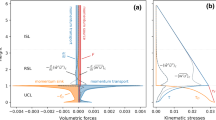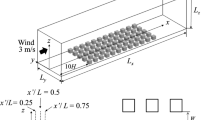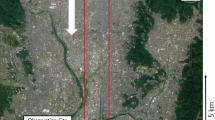Abstract
We perform large-eddy simulations of neutral atmospheric boundary-layer flow over a cluster of buildings surrounded by relatively flat terrain. The first investigated question is the effect of the level of building detail that can be included in the numerical model, a topic not yet addressed by any previous study. The simplest representation is found to give similar results to more refined representations for the mean flow, but not for turbulence. The wind direction on the other hand is found to be important for both mean and turbulent parameters. As many suburban areas are characterised by the clustering of buildings and homes into small areas separated by surfaces of lower roughness, we look at the adjustment of the atmospheric surface layer as it flows from the smoother terrain to the built-up area. This transition has unexpected impacts on the flow; mainly, a zone of global backscatter (energy transfer from the turbulent eddies to the mean flow) is found at the upstream edge of the built-up area.
Similar content being viewed by others
References
Albertson JD, Parlange MB (1999a) Natural integration of scalar fluxes from complex terrain. Adv Water Resour 23(3): 239–252
Albertson JD, Parlange MB (1999b) Surface length scales and shear stress: implications for land–atmosphere interaction over complex terrain. Water Resour Res 35(7): 2121–2132
Albertson JD, Kustas WP, Scanlon TM (2001) Large-eddy simulation over heterogeneous terrain with remotely sensed land surface conditions. Water Resour Res 37(7): 1939–1953
Avissar R (1995) Recent advances in the representation of land–atmosphere interactions in general-circulation models. Rev Geophys 33: 1005–1010
Belcher SE, Jerram N, Hunt JCR (2003) Adjustment of a turbulent boundary layer to a canopy of roughness elements. J Fluid Mech 488: 369–398
Bou-Zeid E, Meneveau C, Parlange MB (2004) Large-eddy simulation of neutral atmospheric boundary layer flow over heterogeneous surfaces: blending height and effective surface roughness. Water Resour Res 40(2): W02505. doi:10.1029/2003WR002475
Bou-Zeid E, Meneveau C, Parlange MB (2005) A scale-dependent Lagrangian dynamic model for large eddy simulation of complex turbulent flows. Phys Fluids 17(2): 025105. doi:10.1063/1.1839152
Bou-Zeid E, Parlange MB, Meneveau C (2007) On the parameterization of surface roughness at regional scales. J Atmos Sci 64(1): 216–227. doi:10.1175/JAS3826.1
Bou-Zeid E, Vercauteren N, Parlange MB, Meneveau C (2008) Scale dependence of subgrid-scale model coefficients: an a priori study. Phys Fluids 20(11): 115106
Bradbrook KF, Lane SN, Richards KS, Biron PM, Roy AG (2000) Large eddy simulation of periodic flow characteristics at river channel confluences. J Hydraul Res 38(3): 207–215
Britter RE, Hanna SR (2003) Flow and dispersion in urban areas. Annu Rev Fluid Mech 35: 469–496
Brutsaert W (1998) Land-surface water vapor and sensible heat flux: spatial variability, homogeneity, and measurement scales. Water Resour Res 34(10): 2433–2442. doi:10.1029/98WR01340
Cai XM (1999) Large-eddy simulation of the convective boundary layer over an idealized patchy urban surface. Q J Roy Meteorol Soc 125(556): 1427–1444
Calhoun R, Gouveia F, Shinn J, Chan S, Stevens D, Lee R, Leone J (2005) Flow around a complex building: experimental and large-eddy simulation comparisons. J Appl Meteorol 44(5): 571–590
Celani A (2007) The frontiers of computing in turbulence: challenges and perspectives. J Turbul 8(1): 1–9
Chen J, Meneveau C, Katz J (2006) Scale interactions of turbulence subjected to a straining–relaxation– destraining cycle. J Fluid Mech 562: 123–150
Cheng H, Castro IP (2002) Near wall flow over urban-like roughness. Boundary-Layer Meteorol 104(2): 229–259
Coceal O, Belcher SE (2004) A canopy model of mean winds through urban areas. Q J Roy Meteorol Soc 130(599): 1349–1372
Dupont S, Mestayer PG (2006) Parameterization of the urban energy budget with the submesoscale soil model. J Appl Meteorol Clim 45(12): 1744–1765
Eliasson I, Offerle B, Grimmond CSB, Lindqvist S (2006) Wind fields and turbulence statistics in an urban street canyon. Atmos Environ 40(1): 1–16
Emeis S (2004a) Parameterization of turbulent viscosity over orography. Meteorol Z 13(1): 33–38
Emeis S (2004b) Vertical wind profiles over an urban area. Meteorol Z 13(5): 353–359
Emeis S, Turk M (2004) Frequency distributions of the mixing height over an urban area from SODAR data. Meteorol Z 13(5): 361–367
Germano M, Piomelli U, Moin P, Cabot WH (1991) A dynamic subgrid-scale eddy viscosity model. Phys Fluids A 3(7): 1760–1765
Grimmond CSB, Oke TR (1999) Aerodynamic properties of urban areas derived, from analysis of surface form. J Appl Meteorol 38(9): 1262–1292
Grimmond CSB, King TS, Roth M, Oke TR (1998) Aerodynamic roughness of urban areas derived from wind observations. Boundary-Layer Meteorol 89(1): 1–24
Harman IN, Belcher SE (2006) The surface energy balance and boundary layer over urban street canyons. Q J Roy Meteorol Soc 132(621): 2749–2768
Kanda M, Moriwaki R, Kasamatsu F (2004) Large-eddy simulation of turbulent organized structures within and above explicitly resolved cube arrays. Boundary-Layer Meteorol 112(2): 343–368
Keylock CJ, Hardy RJ, Parsons DR, Ferguson RI, Lane SN, Richards KS (2005) The theoretical foundations and potential for large-eddy simulation (LES) in fluvial geomorphic and sedimentological research. Earth Sci Rev 71(3–4): 271–304
Kleissl J, Kumar V, Meneveau C, Parlange MB (2006) Numerical study of dynamic Smagorinsky models in large-eddy simulation of the atmospheric boundary layer: validation in stable and unstable conditions. Water Resour Res 42(6): W06D10. doi:10.1029/2005WR004685
Kumar V, Kleissl J, Meneveau C, Parlange MB (2006) Large-eddy simulation of a diurnal cycle of the atmospheric boundary layer: atmospheric stability and scaling issues. Water Resour Res 42(6): W06D09. doi:10.1029/2005WR004651
Lee XH, Black TA (1993) Atmospheric-turbulence within and above a Douglas–Fir stand. 1. Statistical properties of the velocity-field. Boundary-Layer Meteorol 64(1-2): 149–174
Liberzon A, Luthi B, Guala M, Kinzelbach W, Tsinober A (2005) Experimental study of the structure of flow regions with negative turbulent kinetic energy production in confined three-dimensional shear flows with and without buoyancy. Phys Fluids 17(9): 095110
Lilly DK (1967) The representation of small scale turbulence in numerical simulation experiments. In: IBM scientific computing symposium on environmental sciences, White Plains, New York, pp 195–209
Lin CL, Glendening JW (2002) Large eddy simulation of an inhomogeneous atmospheric boundary layer under neutral conditions. J Atmos Sci 59(16): 2479–2497
Lyn DA, Rodi W (1994) The flapping shear-layer formed by flow separation from the forward corner of a square cylinder. J Fluid Mech 267: 353–376
Masson V (2000) A physically-based scheme for the urban energy budget in atmospheric models. Boundary-Layer Meteorol 94(3): 357–397
Meinders ER, Hanjalic K (1999) Vortex structure and heat transfer in turbulent flow over a wall-mounted matrix of cubes. Int J Heat Fluid Flow 20(3): 255–267
Meinders ER, Hanjalic K (2002) Experimental study of the convective heat transfer from in-line and staggered configurations of two wall-mounted cubes. Int J Heat Mass Transf 45(3): 465–482
Meneveau C, Katz J (2000) Scale-invariance and turbulence models for large-eddy simulation. Annu Rev Fluid Mech 32: 1–32
Meneveau C, Lund TS, Cabot WH (1996) A Lagrangian dynamic subgrid-scale model of turbulence. J Fluid Mech 319: 353–385
Moeng CH, Dudhia J, Klemp J, Sullivan P (2007) Examining two-way grid nesting for large eddy simulation of the PBL using the WRF model. Mon Weather Rev 135(6): 2295–2311
Molod A, Salmun H, Waugh DW (2003) A new look at modeling surface heterogeneity: extending its influence in the vertical. J Hydrometeorol 4(5): 810–825
Monin AS, Obukhov AM (1954) Basic laws of turbulent mixing in the ground layer of the atmosphere (in Russian), vol 151. Trudy Geofizicheskogo Instituta, Akademiya Nauk SSSR, pp 163–187
Orszag SA, Pao YH (1974) Numerical computation of turbulent shear flows. Adv Geophys 18(A): 224–236
Parlange MB, Brutsaert W (1993) Regional shear-stress of broken forest from radiosonde wind profiles in the unstable surface-layer. Boundary-Layer Meteorol 64(4): 355–368
Piomelli U (1999) Large-eddy simulation: achievements and challenges. Prog Aerosp Sci 35(4): 335–362
Pope SB (2000) Turbulent flows. Cambridge University Press, Cambridge, p 771
Porte-Agel F, Meneveau C, Parlange MB (2000) A scale-dependent dynamic model for large-eddy simulation: application to a neutral atmospheric boundary layer. J Fluid Mech 415: 261–284
Roberts SM, Oke TR, Grimmond CSB, Voogt JA (2006) Comparison of four methods to estimate urban heat storage. J Appl Meteorol Clim 45(12): 1766–1781
Rotach MW, Fisher B, Piringer M (2002) COST 715 workshop on urban boundary layer parameterizations. Bull Am Meteorol Soc 83(10): 1501–1504
Roth M (2000) Review of atmospheric turbulence over cities. Q J Roy Meteorol Soc 126(564): 941–990
Roth M, Salmond JA, Satyanarayana ANV (2006) Methodological considerations regarding the measurement of turbulent fluxes in the urban roughness sublayer: the role of scintillometery. Boundary-Layer Meteorol 121(2): 351–375
Roulet YA, Martilli A, Rotach MW, Clappier A (2005) Validation of an urban surface exchange parameterization for mesoscale models—1D case in a street canyon. J Appl Meteorol 44(9): 1484–1498
Sagaut P (2003) Large eddy simulation for incompressible flows. Springer, Berlin, p 426
Shaw RH (1977) Secondary wind speed maxima inside plant canopies. J Appl Meteorol 16(5): 514–521
Shen L, Yue DKP (2001) Large-eddy simulation of free-surface turbulence. J Fluid Mech 440: 75–116
Smagorinsky J (1963) General circulation experiments with the primitive equations: I. the basic experiment. Mon Weather Rev 91: 99–164
Stoll R, Porte-Agel F (2006) Dynamic subgrid-scale models for momentum and scalar fluxes in large-eddy simulations of neutrally stratified atmospheric boundary layers over heterogeneous terrain. Water Resour Res 42(1): W01409
Tominaga Y, Mochida A, Murakami S, Sawaki S (2008) Comparison of various revised k-[epsilon] models and LES applied to flow around a high-rise building model with 1:1:2 shape placed within the surface boundary layer. J Wind Eng Ind Aerodyn 96(4): 389–411
Tseng YH, Meneveau C, Parlange MB (2006) Modeling flow around bluff bodies and predicting urban dispersion using large eddy simulation. Environ Sci Technol 40(8): 2653–2662
Wood N (2000) Wind flow over complex terrain: a historical perspective and the prospect for large-eddy modelling. Boundary-Layer Meteorol 96(1-2): 11–32
Xie ZT, Castro IP (2006) LES and RANS for turbulent flow over arrays of wall-mounted obstacles. Flow Turbul Combust 76(3): 291–312
Xie ZT, Li JC (2005) A numerical study for turbulent flow and thermal influence over inhomogenous canopy of roughness elements. Environ Fluid Mech 5(6): 577–597
Yue WS, Meneveau C, Parlange MB, Zhu WH, van Hout R, Katz J (2007a) A comparative quadrant analysis of turbulence in a plant canopy. Water Resour Res 43(5): W05422. doi:10.1029/2006WR005583
Yue WS, Parlange MB, Meneveau C, Zhu WH, van Hout R, Katz J (2007b) Large-eddy simulation of plant canopy flows using plant-scale representation. Boundary-Layer Meteorol 124(2): 183–203
Zhang N, Jiang WM, Miao SG (2006) A large eddy simulation on the effect of buildings on urban flows. Wind Struct 9(1): 23–35
Author information
Authors and Affiliations
Corresponding author
Rights and permissions
About this article
Cite this article
Bou-Zeid, E., Overney, J., Rogers, B.D. et al. The Effects of Building Representation and Clustering in Large-Eddy Simulations of Flows in Urban Canopies. Boundary-Layer Meteorol 132, 415–436 (2009). https://doi.org/10.1007/s10546-009-9410-6
Received:
Accepted:
Published:
Issue Date:
DOI: https://doi.org/10.1007/s10546-009-9410-6




